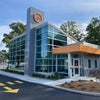Central Massachusetts patent power
Inventions in the region vary from the simple to the simply indecipherable
What do a castanet, a squeeze bottle and a microstrip coil design for an MRI apparatus have in common?
Other than the makings of a truly unique band, all three were among the inventions that Central Massachusetts inventors sought to patent since the beginning of last year.
Most patents approved for inventors in the region seek to protect highly technical processes or devices, but some, like Rick Estabrook of Milford's squeeze bottle design, are just plain old design innovations.
Estabrook, manager of Asia-Pacific business development for Ocean Spray Cranberries Inc., said his design was for the bottle of a new product Ocean Spray was planning to introduce.
"It's just a proprietary shape for the brand," Estabrook explained. He said in his former role as principal packaging engineer at Ocean Spray, he was involved with four or five patents.
"There are two kinds of patents, design patents and utility patents," Estabrook said. "A design patent identifies unique cosmetic features for a container, artistic features. It gives some limited protection from the competition coming out with an identical package."
Supreme ruling
A recent Supreme Court ruling that denies patents to inventions deemed "obvious" has made it more difficult to get new patents and to defend existing ones.
The April 30 decision may have a significant impact on technology and software companies that create new products simply by making small improvements and updates to existing designs. The growing field of "business method" patents, granted for theoretical processes instead of actual devices or products, may also be affected.
The majority of area patent applications were for high-technology devices, such as a navigational control system for a robotic device, submitted by Joseph L. Jones of Acton for Burlington-based iRobot Corp., or for advanced production processes.
Statewide, the Massachusetts Institute of Technology in Cambridge obtained the most patents between 2001 and 2005, according to the US Patent and Trademark Office. MIT obtained 558 patents in that period, ahead of Hopkinton-based EMC Corp. with 524 in the same period.
Worcester-based Morgan Construction Co., designer and manufacturer of rolling steel mill technology, applied for three separate patents in the past year to protect its technology and processes, including a new method for decelerating and subdividing hot-rolled steel.
The company maintains a "wall of patents" in its Worcester headquarters, recognizing the company's 50 most recent patents. The company holds more than 650 patents total, dating to the 1880s, said Dave Pariseau vice president of corporate projects at Morgan.
Pariseau said process patents are the most beneficial to Morgan, because they offer protection in ways simple apparatus patents can't.
Protection
"A person could come up with an alternate design to what our process patent describes, but the process patent will still cover it," Pariseau explained. "Once something is patented, your competition will often look at it and say, ‘Hey, this is a good idea, how can I get around it?' That's where a process patent gives you protection."
Pariseau said that, on average, Morgan submits between six and nine patents per year.









0 Comments